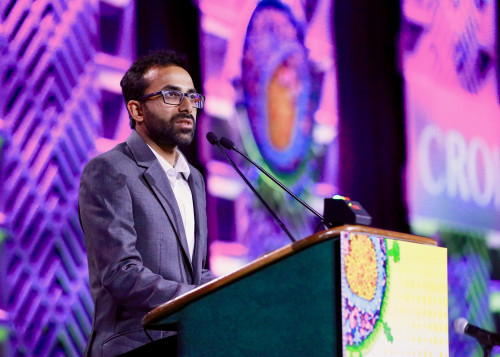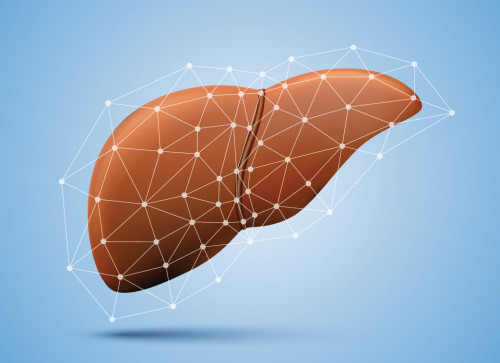Every few years, HIV research presented at the annual Conference on Retroviruses and Opportunistic Infections (CROI) makes international headlines. This was such a year, as the mainstream media trumpeted the finding—announced at the conference, which was held in Seattle from March 4 to 7—that the second-ever man had been cured of HIV.
According to the cautious researcher overseeing the case of the so-called London Patient, the man is actually currently in a state of viral remission. More follow-up time is needed before the London Patient can be officially designated as cured. But such scientific subtleties often fail to make their way into excited headlines.

Ravindra K. Gupta of University College London presenting his findings from the London Patient case at CROI 2019Benjamin Ryan
Scientists attending the conference were certainly excited by the potential for a new official case of HIV cure because it would serve as a proof of concept that HIV can indeed be vanquished. That said, it may come as a surprise to those outside the HIV research bubble that the London Patient case study was only one of many research projects that stoked enthusiasm among CROI attendees.
Collectively, the findings of the most notable studies presented at the conference indicate that scientists are making steady, incremental progress in the global effort to prevent and treat HIV and to better care for those living with the virus.
Below are brief summaries of such top research findings. To read more about any of these studies, click the hyperlinks. For a complete newsfeed of CROI reporting, click here or the #CROI2019 hashtag at the end of the article.
Cure
Like Timothy Brown (aka “the Berlin Patient”) before him, the London Patient received as treatment for cancer a stem cell transplant from a donor with a rare genetic abnormality that yielded HIV-resistant immune cells. Promisingly, the British man received milder treatments to condition his body for the transplants than Brown did.

Timothy Ray Brown, aka the Berlin Patient, watches as Ravindra K. Gupta presents findings about a new case of likely cure of HIV at CROI 2019.Benjamin Ryan
Eighteen months have passed since the London Patient and his clinicians interrupted his antiretroviral (ARV) treatment. Thus far, his virus has not rebounded, and signs suggest that it never will. The researcher overseeing his case told conferencegoers that two to three years of such viral remission would likely be necessary for him to comfortably call the man cured.
Meanwhile, another man, “the Düsseldorf Patient,” received a similar HIV-resistant stem cell transplant and has been off ARVs since November 2018 without a viral rebound. It is much too early to determine whether this man has been cured.
On the gene-editing front, researchers have made progress in the effort to use the CRISPR-Cas9 gene-editing mechanism to deactivate simian HIV in the cells of monkeys. Two monkeys received such a treatment, and, after euthanizing the animals, researchers have not been able to detect virus in their cells.
In a study conducted in humans, scientists tested a gene-editing treatment and successfully prompted a quite modest yet statistically significant (unlikely to have been driven by chance) delay in the rebound of HIV following an interruption of participants’ ARV treatment.
Antiretroviral development
It looks highly likely that the first long-acting injectable ARV regimen will hit the market by about early 2020. A pair of advanced trials of monthly injections of the long-acting formulations of cabotegravir and Edurant (rilpivirine) found that they were as effective at suppressing HIV as standard oral ARV regimens. A big question going forward is whether HIV-positive individuals will prefer going to a clinic every month for a shot of this regimen over making clinic visits only every four or six months but needing to take a pill daily.

Is this the future of HIV treatment?Istock
Further back in the ARV pipeline is Gilead Sciences’ capsid inhibitor, GS-6207, which, according to early research in HIV-negative individuals, could be dosed only every three months.
Care and treatment
Biktarvy (bictegravir/emtricitabine/tenofovir alafenamide), a blockbuster combination ARV tablet approved in February 2018 and is based on the integrase inhibitor bictegravir, continued to suppress HIV well at the 96-week mark in an ongoing advanced trial.

Biktarvy is notable for its small size.
In salvage treatment news, Trogarzo (ibalizumab-uiyk), a weekly injectable antibody treatment approved in March 2018 to treat highly drug-resistant HIV along with an optimized background regimen of daily oral ARVs, maintained stable efficacy two years into the trial that led to its approval.
While the overall rate of viral suppression in the national HIV population, at just above 50 percent, remains quite poor, a National Institutes of Health ARV treatment study conducted at several major HIV research centers found that after a year of treatment, 86 percent of the participants had an undetectable viral load.
Scientists are delving into why some people who adhere well to their ARV treatment regimens nevertheless sustain a detectable, albeit low, viral load. A possibility is that in those individuals’ latently HIV-infected immune cells, the nonreplicating viral reservoir cells that evade ARVs, are cloning themselves.
The long-awaited results from the advanced trial of Descovy (emtricitabine/tenofovir alafenamide) as pre-exposure prophylaxis (PrEP) found that the HIV diagnosis rate was comparably low among men who have sex with men (MSM) participants randomized to receive Descovy compared with those who received Truvada (tenofovir disoproxil fumarate/emtricitabine). If all goes well, Descovy should be approved for use as PrEP by early 2020.

C. Bradley Hare of UCSF presenting data at CROI 2019 from the DISCOVER trial of Descovy vs. Truvada as PrEP.Benjamin Ryan
As expected, Descovy was associated with modest improvements in markers of bone and kidney health compared with Truvada. However, it is unknown whether prescribing Descovy, which contains an updated version of the ARV tenofovir, to HIV-negative individuals will prevent bone fracture or kidney disease compared with prescribing Truvada. Nevertheless, Descovy may be an option for those with a higher risk of such negative health outcomes.

Descovy
Use of PrEP grew fivefold between 2014 and 2017 among MSM at risk for HIV surveyed by Centers for Disease Control and Prevention (CDC) investigators in 20 U.S. cities. Nevertheless, concerning racial disparities seen in countless analyses throughout the PrEP era persist in this ongoing study, which operates in three-year cycles. White men used PrEP at higher rates than their Black and Latino counterparts, despite the much higher rate of HIV transmission seen nationwide in the nonwhite demographics.
Far back in the HIV prevention pipeline is an ARV-containing vaginal insert that was highly effective in preventing female monkeys from acquiring a simian version of the virus.
A study conducted at New York City sexual health clinics found that starting people on PrEP immediately after their first evaluation, rather than waiting to provide a prescription until various lab tests return, was a feasible and effective way to combat the high dropout rate that occurred when people had to wait for those labs before starting PrEP.
Another New York City study looked at data on people recently diagnosed with HIV and found that the use of PrEP at some point prior to diagnosis was associated with viral mutations conferring resistance to one of the drugs in Truvada.
A new frontier in PrEP research involves the assessment of how long people actually stay on Truvada for HIV prevention. A pair of studies found concerning results, with considerable PrEP dropout rates over time, including among young Black MSM in Atlanta, a demographic with an alarmingly high diagnosis rate.
Another study, conducted in Chicago, found that those who harbor stigma toward PrEP are less likely to take it and that those who do take it are less likely to adhere to the daily regimen. Assessing such adherence may soon be easier for health care providers now that researchers have developed a cheap and easy urine test for detecting whether an individual has taken Truvada within the past 24 hours.

TruvadaIstock
Cardiovascular disease
HIV, even when well treated, is associated with about a doubled risk of cardiovascular disease (CVD). With that knowledge in mind, investigators are looking to investigate HIV’s relationship with various forms of such disease. Chronic obstructive pulmonary disease (COPD), an umbrella term for various forms of progressive lung diseases, including emphysema, is associated with about a doubled risk of heart attack.

Smoking causes COPDIstock
Additionally, people with HIV who maintain a high viral load or low CD4 count over time have a higher risk of sudden cardiac death compared with the HIV-negative population. There is no such difference in risk between those with well-treated HIV and those who do not have the virus.
Those who were treated with any of three of the earliest ARVs, including Retrovir (zidovudine, or AZT), Zerit (stavudine, or d4T) and Videx (didanosine, or ddI), may have developed lipodystrophyas a result. Lipodystrophyis an abnormal distribution of body fat in which fat below the skin declines and fat surrounding the organs increases. Such body-fat composition shifts are associated with multiple risk factors for CVD and are apparently irreversible, even years after people discontinue those drugs.
Cancer
Maintaining a detectable viral load or a low CD4 count over time is associated with an increased risk of hepatocellular carcinoma (HCC, the most common form of liver cancer) among those who do not have advanced liver scarring, or fibrosis.

Istock
Lung cancer tends to develop in people with HIV at younger ages and with less smoking experience, including less time since quitting cigarettes, compared with what’s seen in the general population. Given this finding, researchers at CROI argued that national guidelines for lung cancer screening among those with a history of smoking are too narrow for those living with the virus.
A study conducted in Botswana found that among women with breast cancer, having HIV was associated with shorter survival compared with being HIV negative.
Transmission
Shortly before the Seattle conference, the CDC reported concerning findings that the estimated number of HIV transmissions seen in the United States annually, which had declined modestly for five years, leveled off between 2013 and 2016. Nevertheless, CDC researchers told CROI attendees that the time people spend living with transmissible HIV in the United States is narrowing, as people get diagnosed earlier and get on successful ARV treatment sooner after diagnosis.

CDC
The United Kingdom has been particularly successful in narrowing these windows. Such efforts, along with the popularity of PrEP among British MSM, have likely contributed to the considerable drop in HIV transmissions recently seen among such men who routinely visit sexual health clinics.
Injection drug use
As the opioid epidemic rages, overdoses on such drugs are claiming the lives of an increasing number of people with HIV even as the overall death rate declines for this population.
For women living with the virus, having hepatitis C virus and injecting drugs are each associated with a higher rate of syphilis. Researchers theorize that transactional sex—or the exchange of sex for money, drugs or other goods—may be driving this association.
Benjamin Ryan (benryan.net) is POZ’s editor at large, responsible for HIV science reporting. Follow him on Facebook and Twitter.







1 Comment
1 Comment